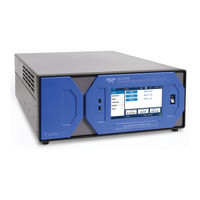Teledyne T201 NH3 Analyzer Manuals
Manuals and User Guides for Teledyne T201 NH3 Analyzer. We have 3 Teledyne T201 NH3 Analyzer manuals available for free PDF download: Operation Manual, Training Manual
Teledyne T201 Operation Manual (452 pages)
Nitrogen Oxide Analyzer
Brand: Teledyne
|
Category: Measuring Instruments
|
Size: 9 MB
Table of Contents
-
Warranty7
-
Introduction27
-
Front Panel33
-
Rear Panel36
-
Shock Hazard40
-
Zero Air49
-
Start up54
-
Faq's63
-
Glossary65
-
Sample Mode92
-
SETUP Mode97
-
Das Status113
-
Led State113
-
DAS Structure114
-
DAS Channels114
-
Report Function126
-
AIN Calibration151
-
Remote Operation153
-
Machine ID159
-
Command Syntax161
-
Data Types161
-
Status Reporting162
-
Communication168
-
Mode Description177
-
Zero Air186
-
Span Gas187
-
Permeation Tubes187
-
CAL on no194
-
Feature194
-
Mode Name203
-
Zero Air213
-
Span Gas213
-
Record Keeping213
-
Zero Calibration220
-
Span Calibration220
-
Gpt no221
-
Check221
-
Precision Check223
-
References225
-
Optical Filter230
-
Nox231
-
Auto Zero232
-
Light Leaks234
-
Sample Gas Flow236
-
Vacuum Manifold238
-
The O Generator241
-
Ozone Scrubber244
-
Overview246
-
Cpu248
-
Flash Chip248
-
Motherboard249
-
Sensor Inputs249
-
Analog Outputs252
-
I 2 C Data Bus253
-
Power-Up Circuit253
-
Relay PCA254
-
Status Led's255
-
Valve Control256
-
Heater Control257
-
PMT Preamplifier261
-
Line Voltage268
-
Adaptive Filter272
-
Changing the no287
-
Converter287
-
High Flow307
-
No Response310
-
Excessive Noise313
-
Slow Response313
-
AC Main Power315
-
DC Power Supply315
-
I 2 C Bus317
-
Relay PCA317
-
Motherboard318
-
A/D Functions319
-
Status Outputs320
-
Control Inputs321
-
Cpu323
-
Communications323
-
NO Converter324
-
Sensor Module332
-
PMT Sensor332
-
Optics Test332
-
Electrical Test333
-
O 3 Generator335
-
General Rules348
-
Default Value377
-
Signal Name386
-
Front Panel I388
-
Factory Option391
Advertisement
Teledyne T201 Operation Manual (425 pages)
NO/NO2/NOX Analyzer
Brand: Teledyne
|
Category: Measuring Instruments
|
Size: 10 MB
Table of Contents
-
Warranty7
-
Introduction17
-
Features17
-
Options18
-
Safety23
-
Emc23
-
Front Panel27
-
Rear Panel31
-
Start up66
-
Interferents70
-
Sample Mode76
-
Setup Mode81
-
INET (Ethernet)101
-
Signal I/O106
-
Optic Test124
-
Electrical Test124
-
Flow Calibration124
-
Com Port Testing128
-
128130
-
Ethernet131
-
Modbus138
-
Hessen140
-
DAS Structure150
-
DAS Channels150
-
Remote Operation171
-
Computer Mode171
-
Interactive Mode172
-
CAL on no189
-
Feature189
-
No Response245
-
Excessive Noise248
-
Slow Response248
-
AC Main Power250
-
DC Power Supply251
-
I 2 C Bus252
-
Relay PCA252
-
Motherboard253
-
Nox253
-
Cpu258
-
Communications258
-
O 3 Generator271
-
Nox287
-
Auto Zero289
-
Sample Gas Flow293
-
Overview304
-
Cpu306
-
Motherboard307
-
Relay PCA312
-
Sensor Module318
-
PMT Preamplifier319
-
Adaptive Filter331
-
Glossary333
-
Index337
Teledyne T201 Training Manual (98 pages)
CHEMILUMINESCENT AMMONIA ANALYZER
Brand: Teledyne
|
Category: Laboratory Equipment
|
Size: 2 MB
Table of Contents
-
User Notes25
-
Maintenance45
-
User Notes71
-
Front Panel85
-
Rear Panel90
Advertisement
Advertisement


